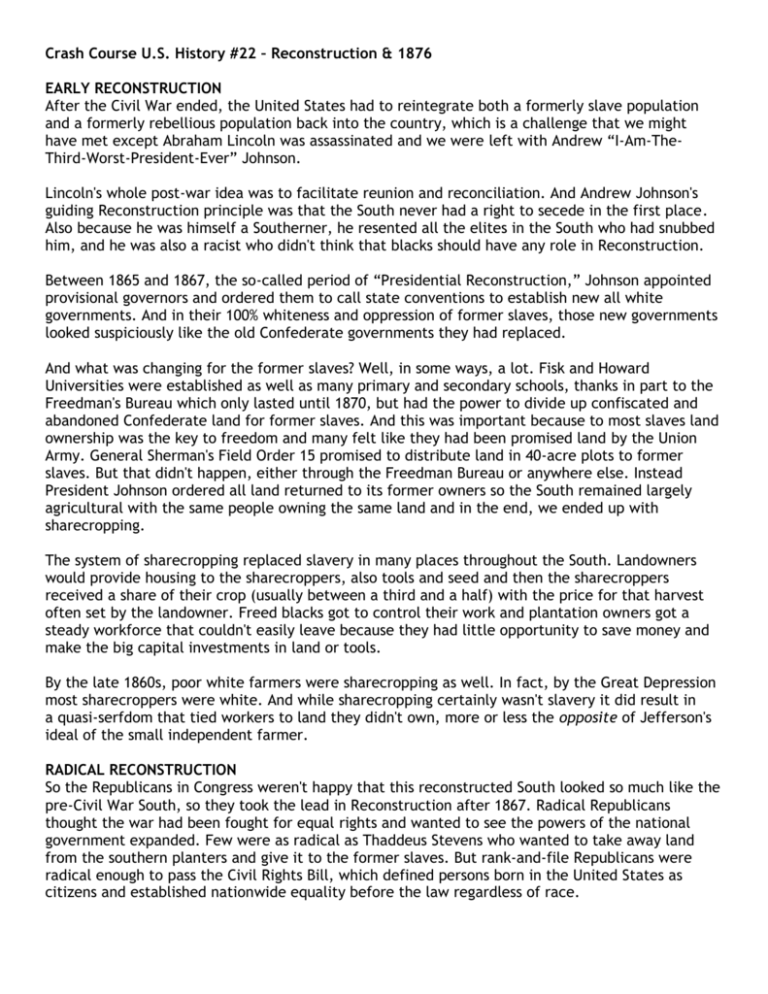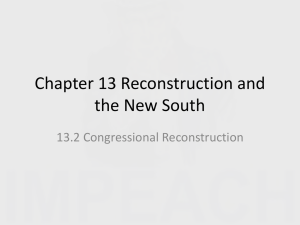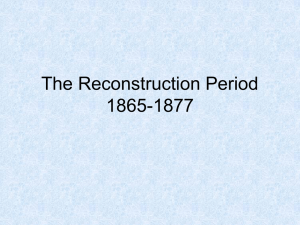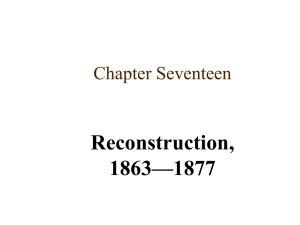Crash Course #22 Transcript
advertisement

Crash Course U.S. History #22 – Reconstruction & 1876 EARLY RECONSTRUCTION After the Civil War ended, the United States had to reintegrate both a formerly slave population and a formerly rebellious population back into the country, which is a challenge that we might have met except Abraham Lincoln was assassinated and we were left with Andrew “I-Am-TheThird-Worst-President-Ever” Johnson. Lincoln's whole post-war idea was to facilitate reunion and reconciliation. And Andrew Johnson's guiding Reconstruction principle was that the South never had a right to secede in the first place. Also because he was himself a Southerner, he resented all the elites in the South who had snubbed him, and he was also a racist who didn't think that blacks should have any role in Reconstruction. Between 1865 and 1867, the so-called period of “Presidential Reconstruction,” Johnson appointed provisional governors and ordered them to call state conventions to establish new all white governments. And in their 100% whiteness and oppression of former slaves, those new governments looked suspiciously like the old Confederate governments they had replaced. And what was changing for the former slaves? Well, in some ways, a lot. Fisk and Howard Universities were established as well as many primary and secondary schools, thanks in part to the Freedman's Bureau which only lasted until 1870, but had the power to divide up confiscated and abandoned Confederate land for former slaves. And this was important because to most slaves land ownership was the key to freedom and many felt like they had been promised land by the Union Army. General Sherman's Field Order 15 promised to distribute land in 40-acre plots to former slaves. But that didn't happen, either through the Freedman Bureau or anywhere else. Instead President Johnson ordered all land returned to its former owners so the South remained largely agricultural with the same people owning the same land and in the end, we ended up with sharecropping. The system of sharecropping replaced slavery in many places throughout the South. Landowners would provide housing to the sharecroppers, also tools and seed and then the sharecroppers received a share of their crop (usually between a third and a half) with the price for that harvest often set by the landowner. Freed blacks got to control their work and plantation owners got a steady workforce that couldn't easily leave because they had little opportunity to save money and make the big capital investments in land or tools. By the late 1860s, poor white farmers were sharecropping as well. In fact, by the Great Depression most sharecroppers were white. And while sharecropping certainly wasn't slavery it did result in a quasi-serfdom that tied workers to land they didn't own, more or less the opposite of Jefferson's ideal of the small independent farmer. RADICAL RECONSTRUCTION So the Republicans in Congress weren't happy that this reconstructed South looked so much like the pre-Civil War South, so they took the lead in Reconstruction after 1867. Radical Republicans thought the war had been fought for equal rights and wanted to see the powers of the national government expanded. Few were as radical as Thaddeus Stevens who wanted to take away land from the southern planters and give it to the former slaves. But rank-and-file Republicans were radical enough to pass the Civil Rights Bill, which defined persons born in the United States as citizens and established nationwide equality before the law regardless of race. Andrew Johnson immediately vetoed the law, claiming that trying to protect the rights of African Americans amounted to discrimination against white people. This so infuriated Republicans that Congress did something it had never done before in all of American history: They overrode the presidential veto with a 2/3rds majority and the Civil Rights Act became law. So then Congress really had its dander up and decided to amend the Constitution with the 14th Amendment, which defines citizenship, guarantees equal protection under the law, and extends the rights in the Bill of Rights to all the states. The amendment had almost no Democratic support, but it also didn't need any because there were almost no Democrats in Congress on account of how Congress had refused to seat the representatives from the new all-white governments that Johnson supported. And that's how we got the 14th Amendment, arguably the most important in the whole Constitution. MYSTERY DOCUMENT SEC. 1. Be it ordained by the police jury of the parish of St.Landry, that no Negro shall be allowed to pass within the limits of said parish without special permit in writing from his employer. Section 4. Every Negro is required to be in the regular service of some white person, or former owner, who shall be held responsible for the conduct of said Negro. Section 6. No Negro shall be permitted to preach, exhort, or otherwise declaim to congregations of colored people, without a special permission in writing from the president of the police jury. – Black Code RADICAL RECONSTRUCTION (cont.) In 1867, again over Johnson's veto, Congress passed The Reconstruction Act, which divided the South into five military districts and required each state to create a new government, one that included participation of black men. Those new governments had to ratify the 14th Amendment if they wanted to get back into the Union. Radical Reconstruction had begun. In 1868, Andrew Johnson was about as electable in the US as Jefferson Davis, and sure enough, he didn't win. Instead the 1868 election was won by Republican and former Union general, Ulysses S. Grant. But Grant's margin of victory was small enough that Republicans were like, “Man, we would sure win more elections if black people could vote!” So Congressional Republicans pushed through the 15th Amendment, which prohibited states from denying men the right to vote based on race, but not based on gender, or literacy, or whether your grandfather could vote. The states ended up with a lot of leeway when it came to denying the franchise to African-Americans, which of course, they did. So here we have the federal government dictating who can vote and who is and isn't a citizen of a state and establishing equality under the law, even local laws. And this is a really big deal in American history because the national government became, rather than a threat to individual liberty, the “custodian of freedom,” as Radical Republican Charles Sumner put it. With this legal protection, former slaves began to emphasize their rights. They participated in the political process by direct action, such as staging sit-ins to integrate streetcars, by voting in elections, and by holding office. Most African Americans were Republicans at the time and because they could vote and were a large part of the population, the Republican Party came to dominate politics in the South. There were about 2,000 African Americans who held office during Reconstruction. Consider Pinckney B.S. Pinchback, who from 1872 to 1873 served very briefly in Louisiana as America's first black governor and went on to be a Senator and a member of the House of Representatives. (By the way, America's second African American governor, Douglas Wilder of Virginia, was elected in 1989.) Having African American office-holders was a huge step forward in terms of ensuring the rights of African Americans, because it meant that there would be black juries and less discrimination in state and local governments when it came to providing basic services. END OF RECONSTRUCTION But in the end, Republican governments failed in the South. There were important achievements, especially a school system that, while segregated, did attempt to educate both black and white children. And even more importantly, they created a functioning government, where both white and African American citizens could participate. According to one white South Carolina lawyer, "We have gone through one of the most remarkable changes in our relations to each other that has been known, perhaps, in the history of the world." It's true that corruption was widespread, but it was in the North, too. And that's not why Reconstruction really ended. It ended because 1) things like schools and road repair cost money, which meant taxes, which made Republican governments very unpopular, because Americans hate taxes. And 2) white Southerners could not accept African Americans exercising basic civil rights, holding office, or voting. And for many, the best way to return things to the way they were before Reconstruction was through violence. Especially after 1867, much of the violence directed toward African Americans in the South was politically motivated. The Ku Klux Klan was founded in 1866, and it quickly became a terrorist organization targeting Republicans, both black and white, beating and murdering men and women in order to intimidate them and keep them from voting. The worst act of violence was probably the massacre at Colfax, Louisiana, where hundreds of former slaves were murdered. Between intimidation and emerging discriminatory voting laws, fewer black men voted, which allowed white Democrats to take control of state governments in the South and returned white Democratic congressional delegations to Washington. These white Southern politicians called themselves "Redeemers", because they claimed to have redeemed the South from Northern Republican corruption and black rule. It's likely that the South would have fallen back into Democratic hands eventually, but the process was aided by Northern Republicans losing interest in Reconstruction. In 1873, the US fell into an economic depression, and Northerners lost the stomach to fight for the rights of black people in the South which (in addition to being hard) was expensive. ELECTION OF 1876 By 1876, the supporters of Reconstruction were in full retreat and the Democrats were resurgent, especially in the South, and this set up one of the most contentious elections in American history. The Democrats nominated New York governor and NYU law school graduate Samuel Tilden. The Republicans chose Ohio governor and Kenyon college alumnus, Rutherford B. Hayes. Now, if this election had been based on facial hair, as elections should be, there would have been no controversy. But we have an Electoral College here in the United States, and in 1876 there were disputed electoral votes in South Carolina, Louisiana, and of course, Florida. Now, you might remember that in these situations, there is a constitutional provision that says Congress should decide the winner, but Congress appointed a 15-man electoral commission with eight Republicans and seven Democrats, so you will never guess who won -- Rutherford B. Hayes! In order to get the presidency and win the support of the electoral commission, Hayes's people agreed to cede control of the South to the Democrats and to stop meddling in Southern affairs and also to build a transcontinental railroad through Texas. This is called the Bargain of 1877 and it basically killed Reconstruction. Without any more troops in Southern states and with control of Southern legislatures firmly in the hands of white Democrats, the states were free to go back to restricting the freedom of black people, which they did. Legislatures passed Jim Crow laws that limited African Americans' access to public accommodations and legal protections. States passed laws that took away black people’s right to vote and social and economic mobility among African Americans in the South declined precipitously [a lot]. CONCLUSION However, for a brief moment, the United States was more democratic than it had ever been before and an entire segment of the population that had no impact on politics before was now allowed to participate. And for the freedmen who'd lived through it, that was a monumental change, and it would echo down to the Civil Rights movement in the 1950s and 1960s, sometimes called "the Second Reconstruction". But we're gonna end this episode on a downer because I want to point out a lesser known legacy of Reconstruction: The Reconstruction amendments and laws that were passed granted former slaves political freedom and rights, especially the vote and that was critical. But to give them what they really wanted and needed, plots of land that would make them economically independent, would have required confiscation, and that violation of property rights was too much for all but the most radical Republicans. And that question of what it really means to be free in a system of freemarket capitalism has proven very complicated indeed. Don't forget to be awesome! Instructions: Fold your blank piece of paper into fourths and label the resulting boxes like this… Early Reconstruction Radical Reconstruction End of Reconstruction Election of 1876 In each box, you may choose to write bullet points or draw diagrams that represent the main ideas of each section. Write your name on the back and submit your work by the end of class today.









